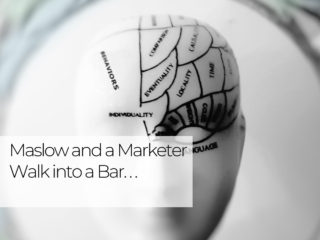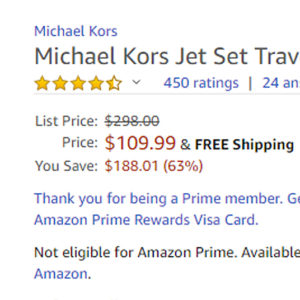
Buyers make decisions they regret. Behavioral science explains why. Marketing can make it worse, or better.
People need stuff. Buying stuff satisfies our need and provides us a benefit, or utility. How do we decide what to buy?
Conventional microeconomics contends that we’re all rational agents who seek to satisfy our needs in a utilitarian way. That is, we evaluate all available information, such as benefits, costs and ROI. Then we make logical economic choices that maximize utility.
In conventional economics, offering a discount should result in more unit sales. Curiously, that isn’t always what happens.
What is behavioral economics?

Anchoring: A large number makes the next number seem smaller. Amazon.com uses this principle extensively.
Psychologist Abraham Maslow suggested that we aren’t so logical about making decisions – that in fact we can make decisions largely on emotion. He was one of the earliest behavioral scientists.
Everybody with a marketing degree or MBA knows about Maslow’s hierarchy of needs. It illustrates a set of situational drivers that offer an explanation for the irrational choices individuals make.
Behavioral economics draws from both psychology and economics to understand the decision-making process behind buying stuff. It studies cognitive, social and emotional influences on people’s economic decision making.
There are about 3,000 behavioral-economics principles, but only 300 apply to marketing. The first is anchoring. If you first state a high number, it will make the next number seem smaller. The other 299 principles are secret (and that’s the second principle).
But, seriously, in 70 years of research into behavioral economics, we’ve proven what Maslow said in the 1940s: Human beings are not just rational utility-maximizers.
Behavioral economics finds that raising the price sometimes results in more unit sales.
What does behavioral economics have to do with marketing?
In my early career I was a Product Manager for point-of-sale barcode scanners. These systems could gather enormous volumes of retail purchasing data, which was a bonanza for marketers.
For the first time, consumer marketers could run small experiments and quickly find which advertising techniques work best. They could run TV spots on Friday and measure sales on Saturday.
Marketing pioneers who had only theorized about behavioral economics found proof: People’s buying behaviors are influenced by emotional, social and cognitive factors in advertising.
Marketing, psychology and behavior change
Advertising wasn’t the only field to discover ways to apply behavioral science. The principles have been applied in weight loss, smoking cessation, drug recovery and other fields.
I got hooked on behavioral economics when I became involved in energy efficiency marketing. In the 16 years since, I’ve read stacks upon stacks of books and academic papers, attended psychology conferences and interviewed leading behavioral scientists for articles and podcasts. I merged the best ideas into B2B marketing.
B2B: Right brain meets left brain

Abraham Maslow. Photo: CC Corbis, NTB scanpix.
A consumer spends mere seconds choosing a soft drink, whereas a B2B software purchasing committee takes months to arrive at a rational decision. It’s obvious why behavioral economics hasn’t caught on in B2B marketing, right?
Not necessarily. The adoption of behavioral economics in B2C marketing was not an overnight sensation. A few marketers were persistent enough to champion the idea. Eventually those pioneers succeeded against the status quo – and leapt ahead of their competitors. Today it is standard practice.
Still, the act of persuading one consumer at the point of sale is quite different from influencing a committee of risk-averse business software buyers. That’s why B2C agencies have had a hard time making inroads into B2B vendors. Yes, business buyers are also consumers, but B2B marketers know there’s much more to it than that.
How behavioral economics makes B2B marketing more effective
If we can use psychology to help people live healthier or kick bad habits, why not apply it ethically to helping businesses make good buying decisions?
Vendors aren’t the only ones frustrated by the symptoms of poor positioning and messaging. Buyers are exasperated, too, when their companies take months to evaluate options, then stall at the end, only to finally give up and settle for the lowest bidder.
The principles of behavioral economics augment solid marketing fundamentals. Marketers who use both blend the two by choosing when to speak to buyers’ rational left brains and when to speak to their social, emotional and cognitive right brains.
Together these two areas of expertise make campaigns more engaging, differentiate vendors, stop discounting and, above all, help buyers identify the best solution without letting their emotional right brains lead them astray.
Utilitarian economics have been the status quo of B2B positioning and messaging for a century, with behavioral economics only recently entering at the fringes. But the rational-actor model is outdated.
To stay ahead in the B2B software marketplace, incorporate behavioral economics into positioning, messaging and communications.